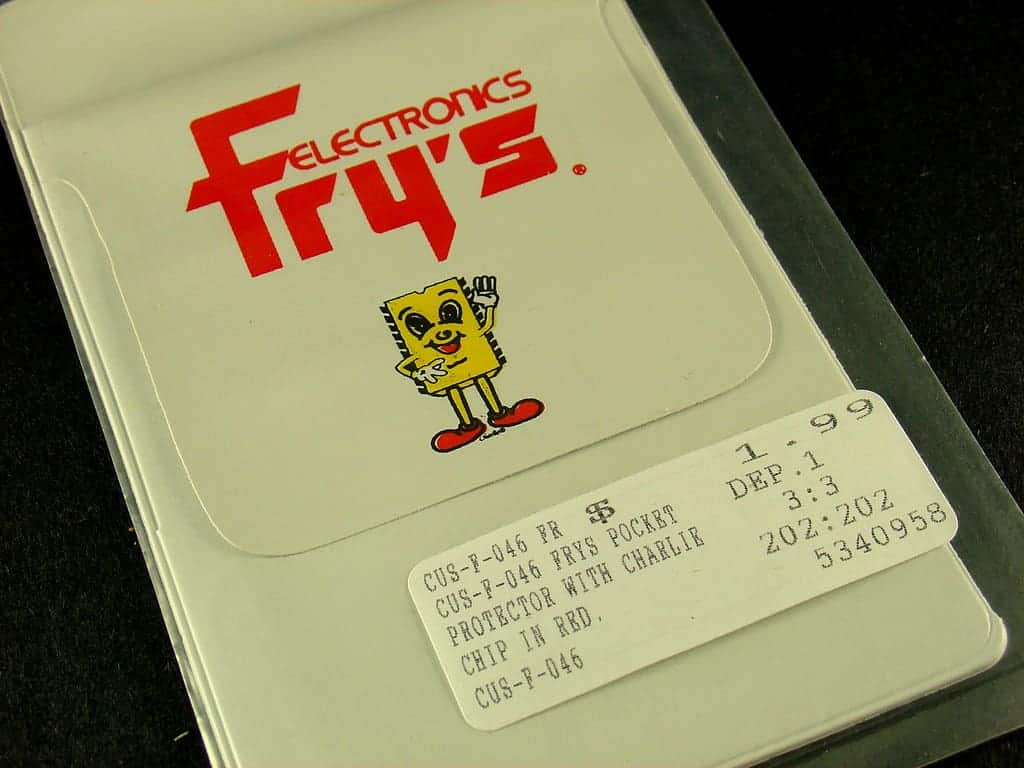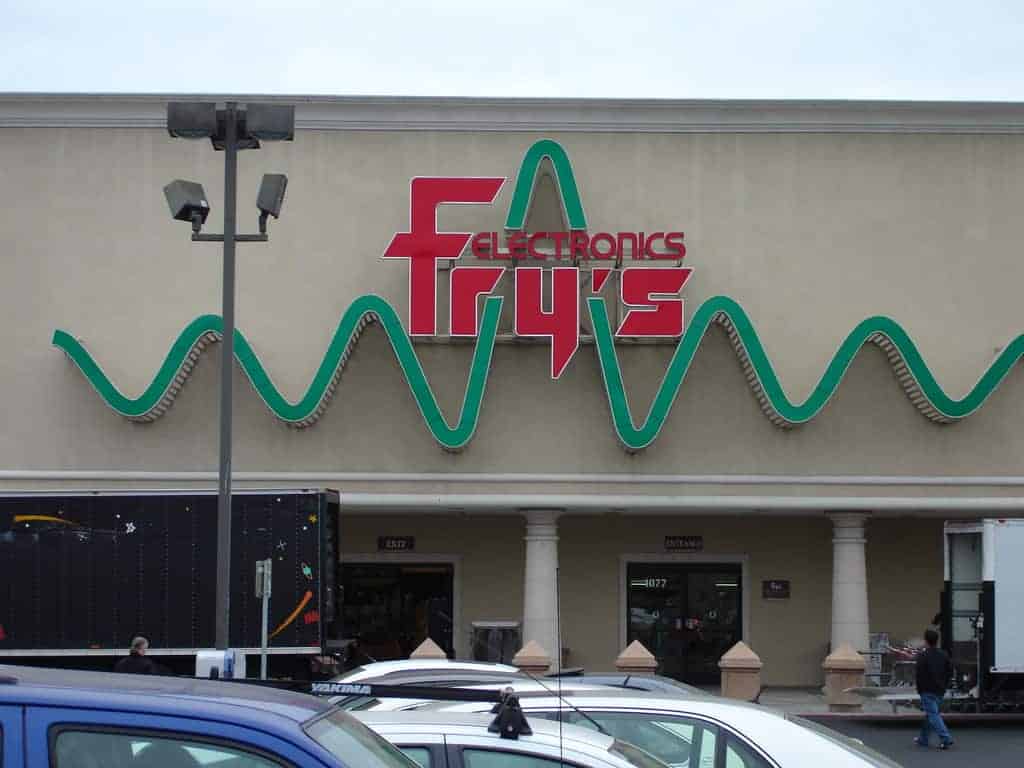In February 2022, Fry’s Electronics (a brick-and-mortar destination for tech enthusiasts and hobbyists) suddenly closed down all of its stores – all 31 locations. This marked the end of an era for a company that had been a fixture in the electronics retail landscape for nearly four decades. The closure of Fry’s Electronics left a void in the electronics retail space, especially for tech enthusiasts who valued the in-store experience of browsing a wide selection of products and components. While other retailers continue to operate in the electronics industry, many people miss Fry’s unique approach to merchandising and its role as a tech haven.
The End of an Era: Why Fry’s Electronics Closed Its Doors
A Perfect Storm of Challenges
While the official statement from Fry’s cited “changes in the retail industry” and the “challenges posed by the Covid-19 pandemic” as reasons for the closure, the reasons behind the company’s decline were more complex. Here’s a breakdown of some key contributing factors:
- The Rise of Online Retail: The convenience and competitive pricing offered by online retailers like Amazon significantly impacted Fry’s business model. Consumers increasingly turned to online platforms for electronics purchases, bypassing the brick-and-mortar experience.
- Shifting Consumer Preferences: Consumer electronics became more standardized and less niche over time. Fry’s, known for its vast and often overwhelming selection of components and parts, struggled to adapt to this shift.
- Challenges in Adapting to the Digital Age: Fry’s lagged behind competitors in developing a strong online presence and omnichannel retail strategy. This made it difficult to compete effectively in the rapidly evolving digital marketplace.
- Financial Strain: These factors all contributed to declining sales and profitability for Fry’s. The company reportedly struggled with debt and was unable to keep pace with the necessary investments in technology and infrastructure.
Fry’s Electronics – A Timeline of Decline
| Year | Event | Impact |
|---|---|---|
| 2010s | Rise of online retail giants like Amazon | Increased competition, shift in consumer buying habits |
| 2010s | Standardization of consumer electronics | Less demand for niche components and parts |
| 2020 | Covid-19 pandemic | Further decline in foot traffic, potential supply chain disruptions |
| February 2022 | Fry’s Electronics announces closure | End of operations for all 31 stores nationwide |
The Closure of Fry’s Electronics
Fry’s Electronics, once a prominent figure among American brick-and-mortar electronics retailers, has ceased operations. The company announced an orderly wind down process, indicating that all of its stores were permanently closing. Characterized by an eclectic mix of tech products and electronic components, Fry’s departure marks the end of what was a technology haven for professionals and enthusiasts alike.
The shutdown was abrupt, leaving customers and employees with little warning. Fry’s Electronics explained their decision as a response to changes within the retail industry, compounded by challenges introduced by the COVID-19 pandemic.
Key Factors Leading to Closure:
- Market Evolution: A shift towards online shopping, competitive pressures, and changing consumer preferences.
- Pandemic Impact: Increased operational difficulties and disrupted business models due to COVID-19.
The company’s closure underscores the broader trend of retail transformations, with more businesses going out of business in the ever-evolving retail landscape. Fry’s Electronics, in its over three decades of operation, expanded to 31 locations across nine states, embedding itself in American tech culture.
Fry’s communicated that it is in the wind down process, suggesting efforts to minimize the impact on stakeholders and maintain compliance as they ceased operations. The news invoked nostalgia and marked a significant shift for the tech retail sector, reflecting the harsh realities of retail sustainability in the modern economy.
Impact of the COVID-19 Pandemic
The COVID-19 pandemic precipitated significant shifts in consumer behavior and the retail landscape, particularly hitting the electronics sector and pushing retailers like Fry’s Electronics to shutter their physical stores.
Effects on Retail Industry
The pandemic caused widespread disruption in the retail industry, with physical stores suffering significant financial hardship. For electronics retailers, the effects were profound as consumer traffic to brick-and-mortar locations plummeted. Fry’s Electronics, a renowned name in the electronics retail industry, had to close all of its stores. Other electronics retailers saw a steep decline in in-store sales as well, reflecting a broader trend beyond individual business strategies.
Transition to Online Shopping
Amidst the pandemic, consumers increasingly turned to online shopping, a transition that benefitted e-commerce giants such as Amazon and specialized retailers like Best Buy, which both reported growth in online sales. The acceleration of e-commerce profoundly affected electronics retailers who traditionally relied on in-person experiences. The pandemic further solidified online retailers’ positions in the market, as they fulfilled the soaring demand for electronics due to the shift towards remote work and entertainment consumption at home.
Financial Challenges and Competition

Fry’s Electronics confronted formidable financial hurdles, exacerbated by intense market pressure. The company grappled with the rapid ascent of online retail giants and the rigors of maintaining liquidity and creditor relationships.
Rise of E-Commerce Giants
The advent of e-commerce titans such as Amazon, Newegg, Computer City, and Best Buy profoundly shifted consumer shopping habits. These platforms not only offered competitive pricing but also excelled in convenience, variety, and quick delivery. As a result, Fry’s Electronics found its once-dominant position eroding, with foot traffic and sales declining.
Struggles with Creditors and Cash Flow
Fry’s Electronics experienced compounding financial stress due to strained relationships with creditors and ongoing cash flow issues. The company faced challenges in securing the inventory necessary to drive sales, as creditors became increasingly hesitant to extend favorable terms. This situation hindered the retailer’s ability to stock its shelves with the latest electronic products, further impacting customer loyalty and revenue.
Fry’s Market Presence and Business Model
Fry’s Electronics was a prominent retailer known for its expansive range of electronics products and distinctive themed stores, attracting a diverse clientele including high-tech professionals.
Historical Overview
Fry’s Electronics established a significant presence in the electronics retail industry with its inception in 1985. Its expansive network peaked at 31 stores across nine states. The company had a stronghold in California, particularly in Silicon Valley, serving as a hub for high-tech professionals and technology enthusiasts. The brand became synonymous with one-stop shopping for computer and electronic components, catering to the needs of both general consumers and specialized sectors.
Store Themes and Customer Experience
Each Fry’s location was unique, featuring a bold theme ranging from Ancient Egyptian to Wild West motifs, designed to enhance the shopping experience. This thematic approach aimed to make shopping entertaining, positioning Fry’s as a retail destination rather than merely a store. The combination of an extensive product range with an engaging store environment established Fry’s as a notable player in the electronics retail space, particularly among customers in Silicon Valley where it was seen as integral to the tech community.
Company Announcements and Stakeholder Reactions

This section explores the official announcement of Fry’s Electronics’ closure and the subsequent reactions from stakeholders and the high-tech community.
Official Communication via Twitter
On a Tuesday in February 2021, Fry’s Electronics relayed an important message about ending its business operations. This communication was made official through the company’s Twitter account, which directed stakeholders and customers to a message on their website, confirming the closure of all their stores and the commencement of the winding-down process.
Reactions from High-Tech Community
The high-tech community and Silicon Valley, where Fry’s had long been an iconic fixture, exhibited a mixture of surprise and nostalgia in response to the news. Many high-tech professionals took to social media and forums to share their personal stories connected to the retailer. Prominent figures like Jean-Louis Gassée, an influential figure in the personal computing industry, shared his views on the closure as a sign of the changing retail landscape. Additionally, reporters like Matthew Keys provided live updates and in-depth reporting on the unfolding story.
Consequences of Shutting Down
The closure of Fry’s Electronics had significant ripple effects, particularly for those directly connected to the company.
Impact on Employees and Associates
Upon the announcement of Fry’s Electronics shutting down, the immediate impact was felt by its workforce. Employees and associates found themselves without employment, prompting a sudden transition in their professional lives. For many, this meant seeking new job opportunities in a challenging retail environment.
Vendor and Creditor Relations
The shutdown of Fry’s not only affected employees but also disrupted the existing relationships with vendors and creditors. Payments and outstanding debts to creditors required resolution, while vendors faced the sudden end of contracts and distribution channels, impacting their business operations and financial health.
- Vendors: Loss of a retail outlet for products; need to find alternative retailers or increase online presence.
- Landlords: Vacancy issues; Fry’s large store footprints required new tenants in a difficult commercial real estate market.
- Creditors: Debt recovery process; need to navigate legal and financial proceedings to recoup losses.
Asset Liquidation and Store Closures
Fry’s Electronics, once a prominent retailer, commenced the liquidation of assets and closure of all its 31 stores. This decisive move marked the end of an era for the well-known chain.
Process of Closing Stores
The decision to close the stores was implemented swiftly. Fry’s Electronics shut down operations overnight, catching many by surprise. They announced the closure on their website, indicating the immediate cessation of regular business operations.
- Timeline: Stores ceased operations effectively overnight.
- Announcement: Closure was communicated via the company’s website.
- Immediate action: All stores were closed without prior public notice to consumers or employees.
Sale and Disposition of Assets
The liquidation process involved selling off all tangible and intangible assets. The company’s inventory was sold through clearance sales. Fixtures and equipment from Fry’s Electronics brick-and-mortar locations were also part of the sale.
Assets Included in Sale:
- Inventory: Electronics goods and other merchandise.
- Store Fixtures: Shelving units, display cases, and registers.
- Equipment: Office and store operational hardware.
Methods of Liquidation:
- Clearance Sales: Conducted to liquidate inventory.
- Direct Sale: Assets made available for purchase by interested buyers.
Customer Experience Post-Closure
Following the closure of Fry’s Electronics, customers encountered significant shifts in their engagement with the company, particularly through online channels and servicing options.
Website and Customer Communications
Customers seeking information regarding Fry’s Electronics post-closure were directed to the company’s website. Upon visiting Fry’s website, they were presented with a message stating the cessation of regular operations. This message provided customers with essential closure details, but subsequent communications were minimal.
- Customer Notices: Brief and to the point, informing visitors of the company’s status.
- Updates: Sparse, with no active promotions or product listings.
Service and Repairs
Fry’s Electronics previously offered various services and repairs which ceased post-closure. Customers with ongoing repair needs were left to seek alternatives as Fry’s facilities became unavailable for servicing products.
- Existing Repairs: Customers with products in repair were given instructions on how to proceed, typically directing them to pick up their items by a certain date.
- Warranty Support: Limited information was provided about warranty support following the closure, with customers generally redirected to manufacturers.
The absence of Fry’s Electronics in the market necessitated customers to turn to other retailers for their electronics needs and after-service support.
Cultural and Regional Influence

Fry’s Electronics was not just a chain of big-box stores; it was a cultural touchstone within Silicon Valley and the broader West Coast region, with a distinct presence in popular culture.
Silicon Valley and West Coast Impact
Fry’s Electronics originated in Silicon Valley, with its first store opening in Sunnyvale, California. Silicon Valley impact: In a region known for its tech industry, Fry’s became synonymous with the tech boom, serving as a one-stop-shop for both enthusiasts and professionals. Stores were strategically located in other tech hubs of the West Coast, including San Jose and Burbank, California.
- Sunnyvale Store: Acclaimed for its history-themed design, it drew in tech aficionados and tourists alike.
- San Jose and Campbell: These locations augmented the Silicon Valley’s retail landscape, providing a wide array of electronics components and consumer goods.
Community Attachment: Residents of these areas saw the Fry’s brand as a community staple that signified the West Coast’s entrepreneurial spirit and technological prowess.
Frequently Asked Questions

This section addresses common queries regarding the closure of Fry’s Electronics.
When Did Frys Open Their First Store?
The first Fry’s Electronics store opened on May 17, 1985 in Sunnyvale, California. The 20,000 sq ft store was opened by the Fry brothers, John, Randy, and Dave, and Kathryn Kolder.
When did Fry’s Electronics officially close its doors?
Fry’s Electronics announced its closure and immediately ceased operations on February 24, 2021.
Has anything taken over the former locations of Fry’s Electronics?
As of now, specifics on new occupants for all former Fry’s locations are not publicly confirmed.
Are there any remaining Fry’s Electronics stores still operating?
No, Fry’s Electronics has shut down all of its stores nationwide and has no remaining active locations.
What were the contributing factors to the closure of Fry’s Electronics?
Contributing factors include increased competition, changes in consumer shopping habits, and the impact of the COVID-19 pandemic.
Is there any potential for Fry’s Electronics to reopen in the future?
There is no indication or public plans suggesting that Fry’s Electronics will reopen in the future.







